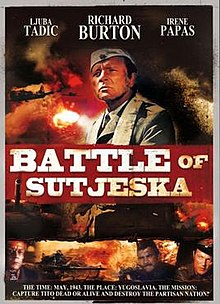The Battle of Sutjeska (film)
| Battle of Sutjeska | |
|---|---|
 |
|
| Directed by | Stipe Delić |
| Produced by | Nikola Popović |
| Written by |
Branimir Šćepanović Sergei Bondarchuk Wolf Mankowitz Miljenko Smoje Orson Welles |
| Starring |
Richard Burton Irene Papas Günter Meisner |
| Music by | Mikis Theodorakis |
| Cinematography | Tomislav Pinter |
| Edited by |
Vojislav Bjenjas Roberto Perpignani |
| Distributed by | American International Pictures |
|
Release date
|
|
|
Running time
|
128 minutes |
| Country | Yugoslavia |
| Language |
Serbo-Croatian English German |
Battle of Sutjeska (also known as The Fifth Offensive) is a 1973 partisan film directed by Stipe Delić and made in SFR Yugoslavia. It tells the story of the famous Battle of Sutjeska, the greatest engagement of the Yugoslav Partisan War. The film is one of the most expensive ever made in Yugoslavia. It was selected as the Yugoslav entry for the Best Foreign Language Film at the 46th Academy Awards, but was not accepted as a nominee. It was also entered into the 8th Moscow International Film Festival where it won a Special Prize.
German-occupied Bosnia and Herzegovina, 1943; under the faithful leadership of Marshal Tito, the Yugoslav Partisans have, for a number of years, put up a staunch fight against the occupying Axis powers. Despite being out-gunned, outmaneuvered and vastly outnumbered, they managed to recuperate in a harsh mountainous region called Durmitor in northern Montenegro. However, their respite is short-lived as the combined foreign and domestic Axis powers begin an encirclement offensive, outnumbering them 6:1. The Partisans have no choice but to fight their way out of the encirclement, then head towards eastern Bosnia. They finally clash with the Axis on the plains of Sutjeska in south-eastern Bosnia.
Various people are caught up in the fighting, such as a Dalmatian who lost all of his children during the war. As the fighting intensifies, the story and the scenes are drawn more and more into the colossal battle as both sides are forced into a conflict that can only be described as a living hell. Battle scenes are interlaced with the personal agonies and fates of the main characters, from supreme commanders to ordinary soldiers.
...
Wikipedia
